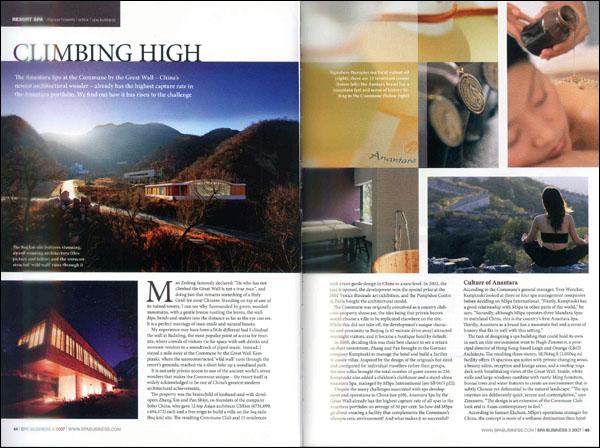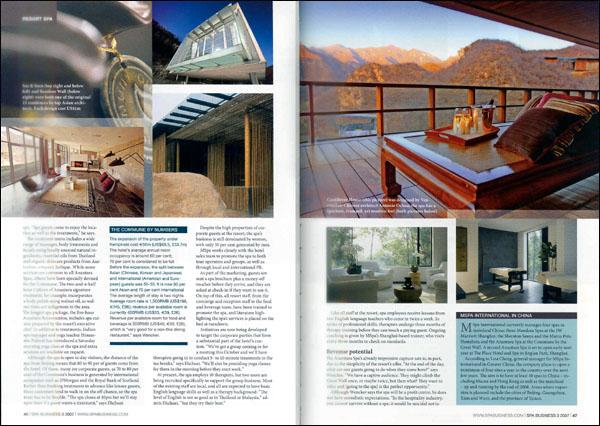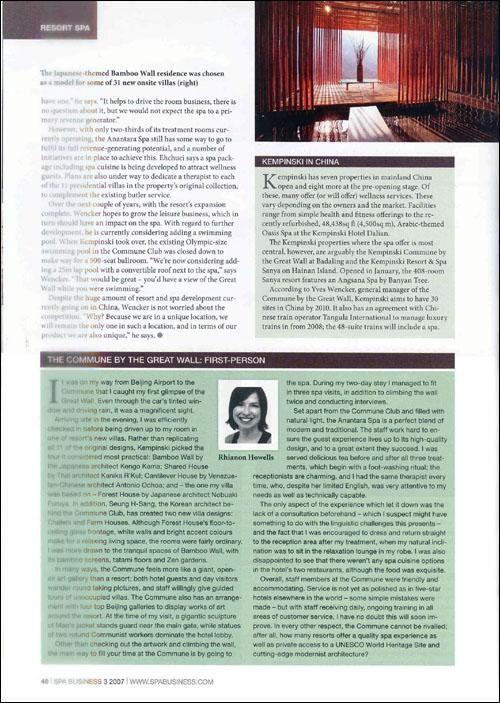
The Anantara Spa at the Commune by the Great Wall - China s newest architectural wonder-already has the highest capture rate in the Anantara portfolio. We find out how it has risen to the challenge.
Mao Zedong famously declared: He who has not climbed the great Wall is not a true man , and doing just that remains something of a Holy Grail for most Chinese. Standing on top of one of its ruined towers, I can see why. Surrounded by green, wooded mountains, with a gentle breeze rustling the leaves, the wall dips, bends and snakes into the distance as far as the eye can see. It is a perfect marriage of man-made and natural beauty.
My experience may have been a little different had I climbed the wall at Badaling, the most popular point of access for tourists, where crowds of visitors vie for space with soft-drinks and souvenir vendors to a soundtrack of piped music. Instead, I stayed a mile away at the Commune by the Great Wall Kempinski, where the unreconstructed wild wall runs through the resort s grounds, reached via a short hike up a woodland path.
It is not only private access to one of the ancient world s seven widely acknowledged to be one of China s greatest modern architectural achievements.
The property was the brainchild of husband-and-wife developers Zhang Xin and Pan Shiyi, co-founders of the company Soho China, who gave 12 top Asian architects US$1m( 731,099, 494,172)each and a free reign to build a villa on the 3sq mile(8sq km)site. The resulting Commune Club and 11 residences took avant-garde design in China to a new level.
In 2002, the year it opened, the development won the special prize at the 2002 Venice Biennale art exhibition, and the Pompidou Centre in Paris bought the architectural model.
The Commune was originally conceived as a country clubcum-property showcase, the idea being that private buyers would choose a villa to be replicated elsewhere on the site. While this did not take off, the development s unique character and proximity to Beijing(a 45-minute drive away) attracted overnight visitors, and it became a boutique hotel by default.
In 2005, deciding this was their best chance to see a return on their investment, Zhang and Pan brought in the German company Kempinski to manage the hotel and build a further 31 onsite villas. Inspired by the design of the originals but sized and configured for individual travelers rather than groups, the new villas brought the total number of guest rooms to 236. Kempinski also added a children s clubhouse and a stand-alone Anantara Spa, managed by MSpa International(see SB 06/3 p22).
Despite the many challenges associated with spa development and operations in China(see p38), Anantara Spa by the Great Wall already has the highest capture rate of all spas in the Anantara portfolio: an average of 30 per cent. So how did MSpa go about creating a facility that complements the Commune s idiosyncratic environment? And what makes it so successful?
Culture of Anantara
According to the Commune s general manager, Yves Wencker, Kempinski looked at three or four spa management companies before deciding on MSpa International. Firstly, Kempinski has a good relationship with MSpa in other parts of the world, he says. Secondly, although MSpa operates three Mandara Spas in mainland China, this is the country s first Anantara Spa. Thirdly, Anantara as a brand has a mountain feel and a sense of history that fits in well with this setting.
The task of designing a spa building that could hold its own in such an elite environment went to Hugh Zimmern, a principal director of Hong Kong-based Leigh and Orange(L&O) Architects. The resulting three-storey,10,764sq ft(1,000sq m) facility offers 15 spacious spa suites with private changing areas, a beauty salon, reception and lounge areas, and a rooftop yoga deck with breathtaking views of the Great Wall.
Inside, white walls and large windows combine with rustic Ming furniture, bonsai trees and water features to create an environment that is subtly Chinese yet deferential to the natural landscape. The spa interiors are deliberately quiet, serene and contemplative, says Zimmern.
The design is an extension of the Commune Club look and is Asian-contemporary in feel.
According to Samart Ehchuei, MSpa s operations manager for China, the concept is more of a wellness destination than hotel spa. Spa guests come to enjoy the location as well as the treatments, he says.
The treatment menu includes a wide range of massages, body treatments and facials using locally sourced natural ingredients, essential oils from Thailand and organic skincare products from Australian company Jurlique.
While some services are common to all Anantara Spas, others have been specially devised for the Commune. The two-and-a-half hour Culture of Anantara signature treatment, for example, incorporates a body polish using walnut oil, as walnut trees are indigenous to the area.
The longest spa package, the five-hour Anantara Rejuvenation, includes spa cuisine prepared by the resort s executive chef. In addition to treatments, Indian spa manager and yoga teacher Himanshu Paliwal has introduced a Saturday morning yoga class at the spa and extra sessions are available on request.
Although the spa is open to day visitors, the distance of the spa from Beijing means that 80 to 90 per of guests come from the hotel. Of these, many are corporate guests, as 70 to 80 per cent of the Commune s business is generated by international companies such as JAMorgan and the Royal Bank of Scotland.
Rather than booking treatments n advance like leisure guests, these customers tend to walk in on the off-chance, so the spa team has to be flexible. The spa closes at 10pm but we ll stay open later if a guest wants a treatment, says Ehchuei.
Despite the high proportion of corporate guests at the resort, the spa s business is still dominated by women, with only 30 per cent generated by men.
MSpa works closely with the hotel sales team to promote the spa to both tour operators and groups, as well as through local and international PR.
As part of the marketing, guests are sent a spa brochure plus a money-off voucher before they arrive, and they are asked at check-in if they want to use it. On top of this, all resort staff, from the concierge and reception staff to the food and beverage team, have been trained to promote the spa, and literature highlighting the spa s services is placed on the bed at turndown.
Initiatives are now being developed to target the corporate parties that form a substantial part of the hotel s custom. We ve gat a group coming in for a meeting this October and we ll have therapists going in to conduct 5-to 10-minute treatments in the tea breaks, says Ehchuei. We ll also be providing yoga classes for them in the morning before they start work.
At present, the spa employs 10 therapists, but two more are being recruited specifically to support the group business. Most of the existing staff are local, and all are expected to have basic English language skills as well as a therapy background: The level of English is not as good as in Thailand or Malaysia, admits Ehchuei, but they try their best.
Like all staff at the resort, spa employees receive lessons from two English language teachers who come in twice a week. In terms of professional skills, therapists undergo three months of therapy training before they can touch a paying guest. Ongoing coaching is given by MSpa s Shanghai-based trainer, who visits every three months to check on standards.

Revenue potential
The Anantara Spa s already impressive capture rate is, in part, due to the simplicity of the resort s offer. At the end of the day, what are our guests going to do when they come here? says Wecker. We have a captive audience. They might climb the Great Wall once, or maybe twice, but then what? They want to relax and (going to the spa)is the perfect opportunity.
Although Wencker says the spa will be a profit centre, he does not have unrealistic expectations. In the hospitality industry, you cannot survive without a spa; it would be suicidal not to have one, he says. It helps to drive the room business, there is no question about it, but we would not expect the spa to a primary revenue generator.
However, with only two-thirds of its treatment rooms currently operating, the Anantara Spa still has some way to go to fulfil its full revenue-generating potential, and a nuembr of initiatives are in place to achieve this. Ehchuei says a spa package including spa cuisine is being developed to attract wellness guests. Plans are also under way to dedicate a therapist to each of the 11 presidential villas in the property s original collection, to complement the existing butler service.
Over the next couple of years, with the resort s expansion complete, Wencker hopes to grow the leisure business, which in turn should have an impact on the spa. With regard to further development, he is currently considering adding a swimming pool. When Kempinski took over, the existing Olympic-size swimming pool in the Commune Club was closed down to make way for a 500-seat ballroom. We re now considering adding a 25m lap pool with a convertible roof next to the spa, says Wencker.
That would be great-you have a view of the Great Wall while you were swimming.
Despite the huge amount of resort and spa development currently going on in China, Wencker is not worried about the competition. Why? Because we are in a unique location, we will remain the only one in such a location, and in terms of our product we are also unique, he says.
THE COMMUNE BY NUMBERS
The expansion of the property under Kempinski cost 50m(US$68.5, 33.7m) The hotel s average annual room occupancy is around 60 per cent; 70 per cent is considered to be full Before the expansion, the split between Asian(Chinese, Korean and Japanese) and international(American and European) guests was 50-50.
it is now 30 per cent Asian and 70 per cent international The average length of stay is two nights Average room rate is 1,500 RMB(US$53, 30, 20), which is very dood for a non-fine dining restaurant, says Wencker.
MAPA INTERNATIONAL IN CHINA
Mspa International currently manages four spas in mainland China: three Mandara Spas at the JW Marriott Shanghai, the Sheraton Sanya and the Marco Polo Shenzhen; and the Anantara Spa at the Commune by the Great Wall. A second Anantara Spa is set to open early next year at The Place Hotel and Spa in Jing an Park, Shanghai.
According to Liza Chang, general manager for MSpa International in Greater China, the company plans to open a minimum of four sites a year in the country over the next few years. The aim is to have at least 10 spas in China-including Macau and Hong Kong as well as the mainland-up and running by the end of 2008. Areas where expansion is planned include the cities of Beijing, Guangzhou, Xian and Wuxi, and the province of Yunan.
KEMPINSKI IN CHINA
Kempinski has seven properties in mainland China open and eight more at the pre-opening stage. Of these, many offer(or will offer)wellness services. These vary depending on the owners and the market. Facilities range from simple health and fitness offerings to the recently refurbished, 48,438sq ft(4,500sq m), Arabic-themed oasis Spa at the Kempinski Hotel Dalian.
The Kempinski properties where the spa offer is most central, however, are arguably the Kempinski Commune by the Great Wall at Badaling and the Kempinski Resort&Spa Sanya on Hainan Island. Opened in January, the 408-room Sanya resort features an Angsana Spa by Banyan Tree.
According to Yves Wencker, general manager of the Commune by the Great Walls, Kempinski aims to have 30 sites in China by 2010. It also has an agreement with Chinese train operator Tangula International to manage luxury trains in from 2008; the 48-suite trains will include a spa.
THE COMMUNE BY THE GREAT WALL:FIRST-PERSON
It was on my way from Beijing Airport to the Commune that I caught my first glimpse of the Great Wall. Even through the car s tinted window and driving rain, it was a magnificent sight.
Arriving late in the evening, I was efficiently all 11 of the original designs, Kempinski picked the four it considered most practical: Bamboo Wall by the Japanese architect Kengo Kama; Shared House by Thai architect R Kul; Cantilever House by Venezuelan-Chinese architect Antonio Ochoa; and-the one my villa was based on-Forest House by Japanese architect Nobuaki Furuya.
In addition, Seung H-sang, the Korean architect behind the Commune Club, has created two new villa designs: Chalets and Farm Houses. Although Forest House s floor-to ceiling glass frontage, white walls and bright accent colours make for a relaxing living space, the rooms were fairly ordinary.
I was more drawn to the tranquil spaces of Bamboo Wall, with its bamboo screens, tatami floors and Zen gardens.
In many ways, the Commune feels more like a giant, open air art gallery than a resort; both hotel guests and day visitors wander round taking pictures, and staff willingly give guided tours of unoccupied villas. The Commune al has an arrangement with four top Beijing galleries to display works of art around the resort. At the time of my visit, a gigantic sculpture of Mao s jacket stands guard near the main gate, while statues of two rotund Communist workers dominate the hotel lobby.
Other than checking out the artwork and climbing the wall, the main way to fill your time at the Commune is by going to the spa. During my two-day stay I managed to fit in three spa visits, in addition to climbing the wall twice and conducting interviews.
Set apart from the Commune Club and filled with natural light, the Anantana Spa is a perfect blend of modern and traditional. The staff work hard to ensure the guest experience lives up to its high-quality design, and to a great extent they succeed. I was served delicious tea before and after all three treatments, which begin with a foot-washing ritual; the receptionists are charming, and I had the same therapist every time, who, despite her limited English, was very attentive to my needs as well as technically capable.
The only aspect of the experience which let it down was the lack of a consultation beforehand-which I suspect might have something to do with the linguistic challenges this presents-and the fact that I was encouraged to dress and return straight to the reception area after my treatment, when my natural inclination was to sit in the relaxation lounge in my robe. I was also disappointed to see that there weren t any spa cuisine options in the hotel s two restaurants, although the food was exquisite.
Overall, staff members at the Commune were friendly and accommodating. Service is not yet as polished as in five-star hotels elsewhere in the world-some simple mistakes were made-but with staff receiving daily, ongoing training in all areas of customer service, I have no doubt this will soon improve. In every other respect, the Commune cannot be rivaled; after all, how many resorts offer a quality spa experience as well as private access to a UNESCO World Heritage Site and cutting-edge modernist architecture?









